RFaNet: Receptive Field-Aware Network with Finger Attention for Fingerspelling Recognition Using a Depth Sensor
Abstract
:1. Introduction
- We introduce RFaNet for effective fingerspelling recognition.
- The DFA block on the top of RFaNet highlights the finger regions and facilitates the identification of slight hand-posture variations across signs with inter-class similarity.
- The NLRF block at the bottom of RFaNet captures inter-finger relations by fusing multi-scale feature maps of various RFs. By learning the representations of inter-finger relations, the NLRF block improves the recognition of signs with intra-class variability because the representation of a sign is invariant to viewpoint changes.
- RFaNet outperformed state-of-the-art methods on two standard benchmark fingerspelling datasets.
- RFaNet effectively learned the fingerspelling representations from large- to small-scale datasets by highlighting the finger regions when the training data were insufficient.
2. Related Work
2.1. Fingerspelling Recognition
2.2. Receptive Field
2.3. Attention Mechanism
3. Receptive Field-Aware Network with Finger Attention
3.1. Depth Finger Attention Block
3.2. Non-Local Receptive Field Block
3.3. Optimization
4. Experimental Results
4.1. Datasets
4.2. Hand Detection and Depth Map Enhancement
4.3. Training and Testing
4.4. Comparison of Different RF Blocks
4.5. Effect of Different Receptive Fields in NLRF Block
4.6. Qualitative Analysis of Various Receptive Fields in NLRF Block
4.7. Effects of DFA and NLRF Blocks
4.8. Qualitative Analysis of DFA and NLRF Blocks
4.9. Comparison with State-of-The-Art Methods
5. Extensive Experimental Results of RFaNet in Transfer Learning
5.1. Implementation Details of Transfer Learning
5.2. Quantitative Results of Transfer Learning on NTU Dataset
5.3. Quantitative Results of Transfer Learning on OUHANDS Dataset
5.4. Qualitative Results of Transfer Learning
5.5. Network Visualization of Transfer Learning
5.6. Failure Modes
6. Discussion
6.1. Effectiveness of the DFA and NLRF Blocks
6.2. Transfer Learning for Fingerspelling Recognition
6.3. Implementation in Actual Application
7. Conclusions
Author Contributions
Funding
Data Availability Statement
Acknowledgments
Conflicts of Interest
References
- Padden, C.A.; Gunsauls, D.C. How the alphabet came to be used in a sign language. Sign Lang. Stud. 2003, 4, 10–33. [Google Scholar] [CrossRef]
- Tsai, Y.-S.; Hsu, L.-H.; Hsieh, Y.-Z.; Lin, S.-S. The real-time depth estimation for an occluded person based on a single image and OpenPose method. Mathematics 2020, 8, 1333. [Google Scholar] [CrossRef]
- Pugeault, N.; Bowden, R. Spelling it out: Real-time ASL fingerspelling recognition. In Proceedings of the IEEE International Conference on Computer Vision Workshops (ICCV Workshops), Barcelona, Spain, 6–13 November 2011; pp. 1114–1119. [Google Scholar]
- Rioux-Maldague, L.; Giguère, P. Sign language fingerspelling classification from depth and color images using a deep belief network. In Proceedings of the IEEE Canadian Conference on Computer and Robot Vision, Montreal, QC, Canada, 6–9 May 2014; pp. 92–97. [Google Scholar]
- Tian, M.; Yi, S.; Li, H.; Li, S.; Zhang, X.; Shi, J.; Yan, J.; Wang, X. Eliminating background-bias for robust person re-identification. In Proceedings of the IEEE Conference on Computer Vision and Pattern Recognition, Salt Lake City, UT, USA, 18–23 June 2018; pp. 5794–5803. [Google Scholar]
- Modanwal, G.; Sarawadekar, K. A robust wrist point detection algorithm using geometric features. Pattern Recognit. Lett. 2018, 110, 72–78. [Google Scholar] [CrossRef]
- Chen, L.-C.; Papandreou, G.; Kokkinos, I.; Murphy, K.; Yuille, A.L. Deeplab: Semantic image segmentation with deep convolutional nets, atrous convolution, and fully connected crfs. IEEE Trans. Pattern Anal. Mach. Intell. 2017, 40, 834–848. [Google Scholar] [CrossRef]
- Liu, S.; Huang, D. Receptive field block net for accurate and fast object detection. In Proceedings of the European Conference on Computer Vision (ECCV), Munich, Germany, 8–14 September 2018; pp. 385–400. [Google Scholar]
- Wang, X.; Girshick, R.; Gupta, A.; He, K. Non-local neural networks. In Proceedings of the IEEE Conference on Computer Vision and Pattern Recognition, Salt Lake City, UT, USA, 18–23 June 2018; pp. 7794–7803. [Google Scholar]
- Cui, Y.; Song, Y.; Sun, C.; Howard, A.; Belongie, S. Large scale fine-grained categorization and domain-specific transfer learning. In Proceedings of the IEEE Conference on Computer Vision and Pattern Recognition, Salt Lake City, UT, USA, 18–23 June 2018; pp. 4109–4118. [Google Scholar]
- Nihal, R.A.; Rahman, S.; Broti, N.M.; Deowan, S.A. Bangla Sign Alphabet Recognition with Zero-shot and Transfer Learning. Pattern Recognit. Lett. 2021, 150, 84–93. [Google Scholar] [CrossRef]
- Deng, J.; Dong, W.; Socher, R.; Li, L.-J.; Li, K.; Fei-Fei, L. Imagenet: A large-scale hierarchical image database. In Proceedings of the IEEE Conference on Computer Vision and Pattern Recognition, Miami, FL, USA, 20–25 June 2009; pp. 248–255. [Google Scholar]
- Bird, J.J.; Ekárt, A.; Faria, D.R. British sign language recognition via late fusion of computer vision and leap motion with transfer learning to american sign language. Sensors 2020, 20, 5151. [Google Scholar] [CrossRef]
- Simonyan, K.; Zisserman, A. Very deep convolutional networks for large-scale image recognition. arXiv 2014, arXiv:1409.1556. [Google Scholar]
- Hu, Y.; Zhao, H.-F.; Wang, Z.-G. Sign language fingerspelling recognition using depth information and deep belief networks. Int. J. Pattern Recognit. Artif. Intell. 2018, 32, 1850018. [Google Scholar] [CrossRef]
- Zhang, C.; Tian, Y. Histogram of 3D facets: A depth descriptor for human action and hand gesture recognition. Comput. Vis. Image Underst. 2015, 139, 29–39. [Google Scholar] [CrossRef]
- Wang, C.; Liu, Z.; Chan, S.-C. Superpixel-based hand gesture recognition with kinect depth camera. IEEE Trans. Multimed. 2014, 17, 29–39. [Google Scholar] [CrossRef]
- Tao, W.; Leu, M.C.; Yin, Z. American Sign Language alphabet recognition using Convolutional Neural Networks with multiview augmentation and inference fusion. Eng. Appl. Artif. Intell. 2018, 76, 202–213. [Google Scholar] [CrossRef]
- Wang, Y.; Wu, T.; Yang, J.; Wang, L.; An, W.; Guo, Y. DeOccNet: Learning to see through foreground occlusions in light fields. In Proceedings of the IEEE/CVF Winter Conference on Applications of Computer Vision, Village, CO, USA, 1–5 March 2020; pp. 118–127. [Google Scholar]
- Tan, Y.S.; Lim, K.M.; Tee, C.; Lee, C.P.; Low, C.Y. Convolutional neural network with spatial pyramid pooling for hand gesture recognition. Neural Comput. Appl. 2021, 33, 5339–5351. [Google Scholar] [CrossRef]
- Lu, R.; Xue, F.; Zhou, M.; Ming, A.; Zhou, Y. Occlusion-shared and feature-separated network for occlusion relationship reasoning. In Proceedings of the IEEE/CVF International Conference on Computer Vision, Seoul, Korea, 27–28 October 2019; pp. 10343–10352. [Google Scholar]
- Hu, J.; Shen, L.; Sun, G. Squeeze-and-excitation networks. In Proceedings of the IEEE Conference on Computer Vision and Pattern Recognition, Salt Lake City, UT, USA, 18–22 June 2018; pp. 7132–7141. [Google Scholar]
- Vaswani, A.; Shazeer, N.; Parmar, N.; Uszkoreit, J.; Jones, L.; Gomez, A.N.; Kaiser, Ł.; Polosukhin, I. Attention is all you need. In Proceedings of the Advances in Neural Information Processing Systems, Long Beach, CA, USA, 4–9 December 2017; pp. 5998–6008. [Google Scholar]
- Wang, L.; Wang, Y.; Liang, Z.; Lin, Z.; Yang, J.; An, W.; Guo, Y. Learning parallax attention for stereo image super-resolution. In Proceedings of the IEEE Conference on Computer Vision and Pattern Recognition, Long Beach, CA, USA, 16–20 June 2019; pp. 12250–12259. [Google Scholar]
- Han, B.; Yin, J.; Luo, X.; Jia, X. Multibranch Spatial-Channel Attention for Semantic Labeling of Very High-Resolution Remote Sensing Images. IEEE Geosci. Remote. Sens. Lett. 2020, 1–5. [Google Scholar] [CrossRef]
- Liu, N.; Zhang, N.; Han, J. Learning selective self-mutual attention for RGB-D saliency detection. In Proceedings of the IEEE/CVF Conference on Computer Vision and Pattern Recognition, Seattle, WA, USA, 16–18 June 2020; pp. 13756–13765. [Google Scholar]
- Yang, S.-H.; Chen, W.-R.; Huang, W.-J.; Chen, Y.-P. DDaNet: Dual-Path Depth-Aware Attention Network for Fingerspelling Recognition Using RGB-D Images. IEEE Access 2020, 9, 7306–7322. [Google Scholar] [CrossRef]
- Nair, V.; Hinton, G.E. Rectified linear units improve restricted boltzmann machines. In Proceedings of the 27th International Conference on International Conference on Machine Learning, Haifa, Israel, 21–24 June 2010; pp. 807–814. [Google Scholar]
- Wang, P.; Chen, P.; Yuan, Y.; Liu, D.; Huang, Z.; Hou, X.; Cottrell, G. Understanding convolution for semantic segmentation. In Proceedings of the 2018 IEEE Winter Conference on Applications of Computer Vision (WACV), Lake Tahoe, NV, USA, 12–15 March 2018; pp. 1451–1460. [Google Scholar]
- Cao, Y.; Xu, J.; Lin, S.; Wei, F.; Hu, H. Gcnet: Non-local networks meet squeeze-excitation networks and beyond. In Proceedings of the IEEE/CVF International Conference on Computer Vision Workshops, Seoul, Korea, 27–28 October 2019; pp. 1–10. [Google Scholar]
- Liu, Z.; Li, J.; Shen, Z.; Huang, G.; Yan, S.; Zhang, C. Learning efficient convolutional networks through network slimming. In Proceedings of the IEEE International Conference on Computer Vision, Venice, Italy, 22–29 October 2017; pp. 2736–2744. [Google Scholar]
- Ren, Z.; Yuan, J.; Zhang, Z. Robust hand gesture recognition based on finger-earth mover’s distance with a commodity depth camera. In Proceedings of the 19th ACM International Conference on Multimedia, Scottsdale, AZ, USA, 28 November–1 December 2011; pp. 1093–1096. [Google Scholar]
- Matilainen, M.; Sangi, P.; Holappa, J.; Silvén, O. OUHANDS database for hand detection and pose recognition. In Proceedings of the Sixth International Conference on Image Processing Theory, Tools and Applications (IPTA), Oulu, Finland, 12–15 December 2016; pp. 1–5. [Google Scholar]
- Otsu, N. A threshold selection method from gray-level histograms. IEEE Trans. Syst. Man Cybern. 1979, 9, 62–66. [Google Scholar] [CrossRef] [Green Version]
- Rosenfeld, A.; Pfaltz, J.L. Sequential operations in digital picture processing. JACM 1966, 13, 471–494. [Google Scholar] [CrossRef]
- Selvaraju, R.R.; Cogswell, M.; Das, A.; Vedantam, R.; Parikh, D.; Batra, D. Grad-cam: Visual explanations from deep networks via gradient-based localization. In Proceedings of the IEEE International Conference on Computer Vision, Venice, Italy, 22–29 October 2017; pp. 618–626. [Google Scholar]
- Kuznetsova, A.; Leal-Taixé, L.; Rosenhahn, B. Real-time sign language recognition using a consumer depth camera. In Proceedings of the IEEE International Conference on Computer Vision Workshops, Sydney, Australia, 2–8 December 2013; pp. 83–90. [Google Scholar]
- Wang, Y.; Yang, R. Real-time hand posture recognition based on hand dominant line using kinect. In Proceedings of the 2013 IEEE International Conference on Multimedia and Expo Workshops (ICMEW), San Jose, CA, USA, 15–19 July 2013; pp. 1–4. [Google Scholar]
- Dong, C.; Leu, M.C.; Yin, Z. American sign language alphabet recognition using microsoft kinect. In Proceedings of the IEEE Conference on Computer Vision and Pattern Recognition Workshops, Boston, MA, USA, 7–12 June 2015; pp. 44–52. [Google Scholar]
- Kane, L.; Khanna, P. A framework for live and cross platform fingerspelling recognition using modified shape matrix variants on depth silhouettes. Comput. Vis. Image Underst. 2015, 141, 138–151. [Google Scholar] [CrossRef]
- Suau, X.; Alcoverro, M.; López-Méndez, A.; Ruiz-Hidalgo, J.; Casas, J.R. Real-time fingertip localization conditioned on hand gesture classification. Image Vis. Comput. 2014, 32, 522–532. [Google Scholar] [CrossRef] [Green Version]
- Feng, B.; He, F.; Wang, X.; Wu, Y.; Wang, H.; Yi, S.; Liu, W. Depth-projection-map-based bag of contour fragments for robust hand gesture recognition. IEEE Trans. Hum. Mach. Syst. 2016, 47, 511–523. [Google Scholar] [CrossRef]
- Warchoł, D.; Kapuściński, T.; Wysocki, M. Recognition of fingerspelling sequences in polish sign language using point clouds obtained from depth images. Sensors 2019, 19, 1078. [Google Scholar] [CrossRef] [Green Version]
- Ameen, S.; Vadera, S. A convolutional neural network to classify American Sign Language fingerspelling from depth and colour images. Expert Syst. 2017, 34, e12197. [Google Scholar] [CrossRef] [Green Version]
- Nai, W.; Liu, Y.; Rempel, D.; Wang, Y. Fast hand posture classification using depth features extracted from random line segments. Pattern Recognit. 2017, 65, 1–10. [Google Scholar] [CrossRef]
- Maqueda, A.I.; del-Blanco, C.R.; Jaureguizar, F.; García, N. Human–computer interaction based on visual hand-gesture recognition using volumetric spatiograms of local binary patterns. Comput. Vis. Image Underst. 2015, 141, 126–137. [Google Scholar] [CrossRef] [Green Version]
- Keskin, C.; Kıraç, F.; Kara, Y.E.; Akarun, L. Hand pose estimation and hand shape classification using multi-layered randomized decision forests. In Proceedings of the European Conference on Computer Vision, Florence, Italy, 7–13 October 2012; pp. 852–863. [Google Scholar]
- Rady, M.A.; Youssef, S.M.; Fayed, S.F. Smart Gesture-based Control in Human Computer Interaction Applications for Special-need People. In Proceedings of the IEEE Novel Intelligent and Leading Emerging Sciences Conference (NILES), Cairo, Egypt, 28–30 October 2019; pp. 244–248. [Google Scholar]
- Aly, W.; Aly, S.; Almotairi, S. User-Independent American Sign Language Alphabet Recognition Based on Depth Image and PCANet Features. IEEE Access 2019, 7, 123138–123150. [Google Scholar] [CrossRef]
- Rakowski, A.; Wandzik, L. Hand shape recognition using very deep convolutional neural networks. In Proceedings of the 2018 International Conference on Control and Computer Vision, Singapore, 15–18 June 2018; pp. 8–12. [Google Scholar]
- Yosinski, J.; Clune, J.; Bengio, Y.; Lipson, H. How transferable are features in deep neural networks? Adv. Neural Inf. Process. Syst. 2014, 27, 3320–3328. [Google Scholar]
- He, K.; Zhang, X.; Ren, S.; Sun, J. Deep residual learning for image recognition. In Proceedings of the IEEE Conference on Computer Vision and Pattern Recognition, Las Vegas, NV, USA, 27–30 June 2016; pp. 770–778. [Google Scholar]
- Huang, G.; Liu, Z.; Van Der Maaten, L.; Weinberger, K.Q. Densely connected convolutional networks. In Proceedings of the IEEE Conference on Computer Vision and Pattern Recognition, Honolulu, HI, USA, 21–26 July 2017; pp. 4700–4708. [Google Scholar]
- Howard, A.G.; Zhu, M.; Chen, B.; Kalenichenko, D.; Wang, W.; Weyand, T.; Andreetto, M.; Adam, H. Mobilenets: Efficient convolutional neural networks for mobile vision applications. arXiv 2017, arXiv:1704.04861. [Google Scholar]
- Dadashzadeh, A.; Targhi, A.T.; Tahmasbi, M.; Mirmehdi, M. HGR-Net: A fusion network for hand gesture segmentation and recognition. IET Comput. Vis. 2019, 13, 700–707. [Google Scholar] [CrossRef] [Green Version]
- Tajbakhsh, N.; Shin, J.Y.; Gurudu, S.R.; Hurst, R.T.; Kendall, C.B.; Gotway, M.B.; Liang, J. Convolutional neural networks for medical image analysis: Full training or fine tuning? IEEE Trans. Med. Imaging 2016, 35, 1299–1312. [Google Scholar] [CrossRef] [Green Version]
- Wikipedia. American Manual Alphabet. Available online: http://en.wikipedia.org/wiki/American_manual_alphabet (accessed on 1 October 2021).
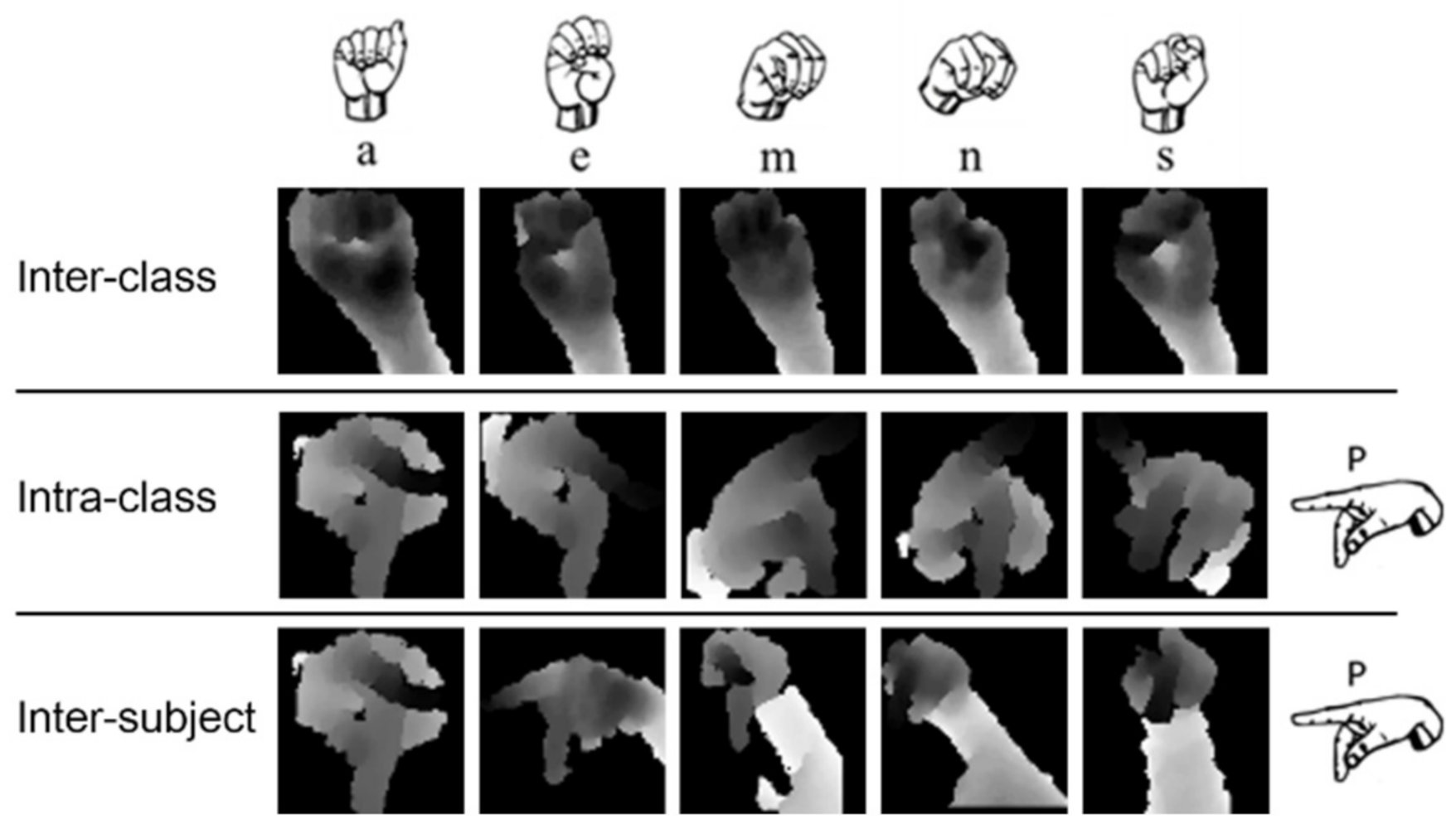



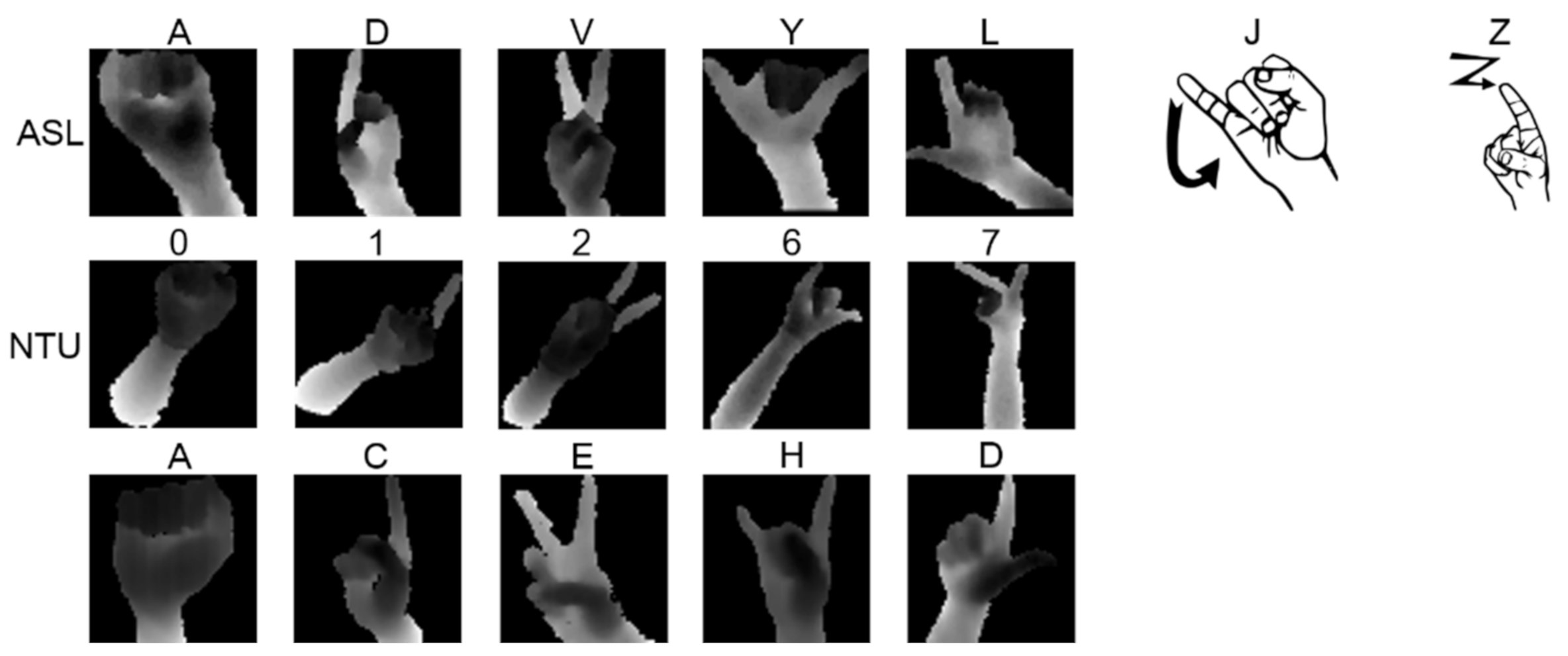
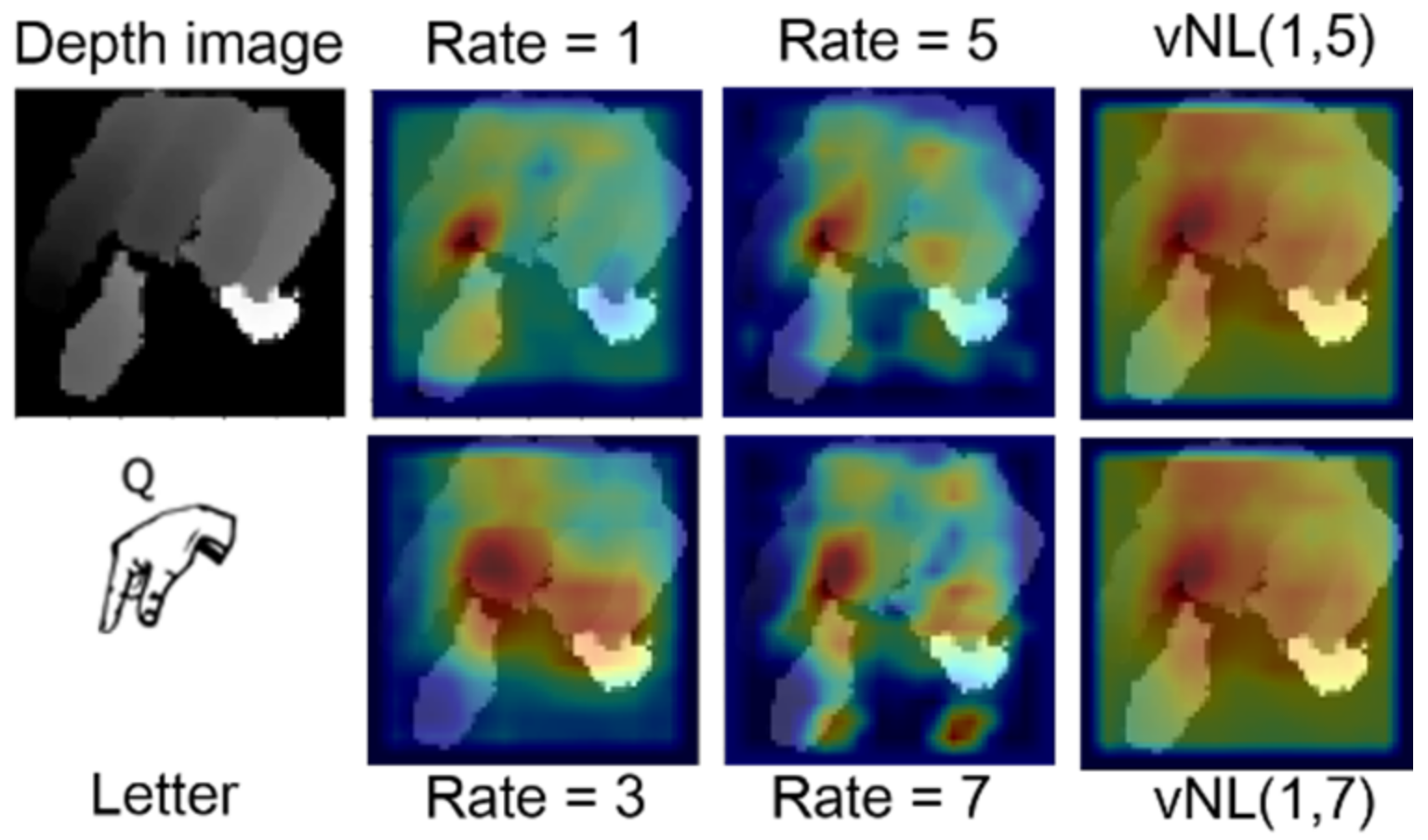
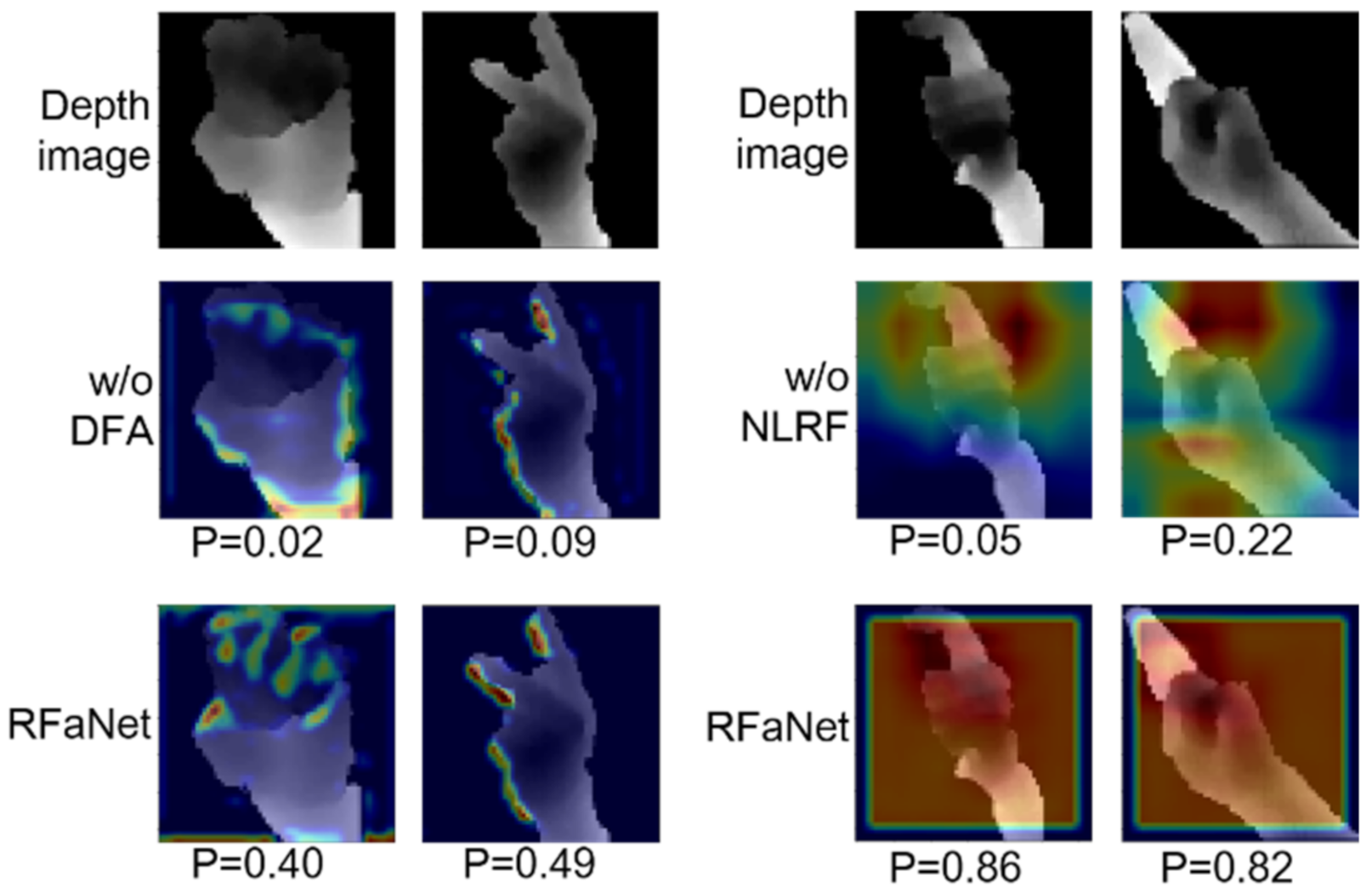
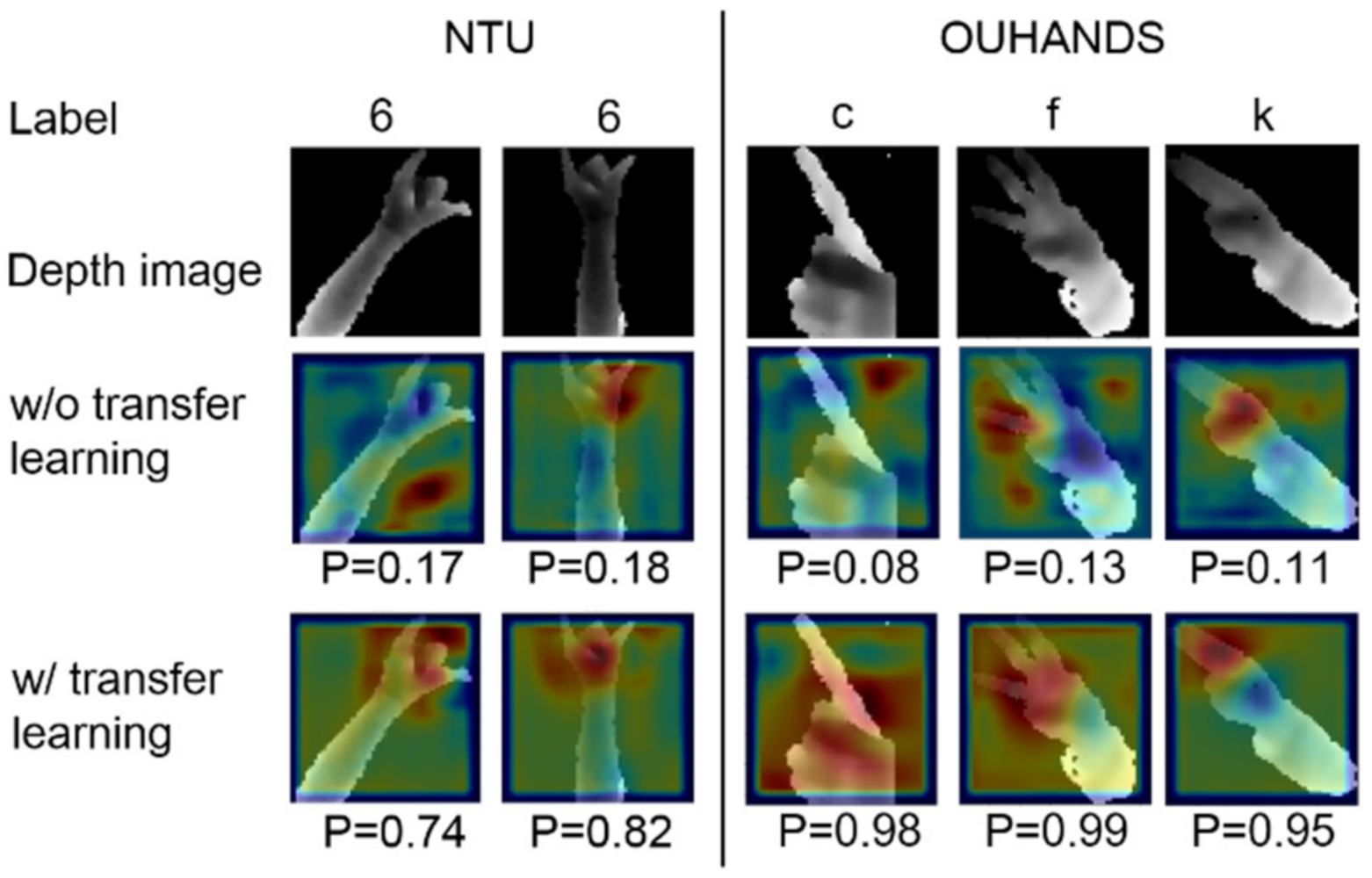

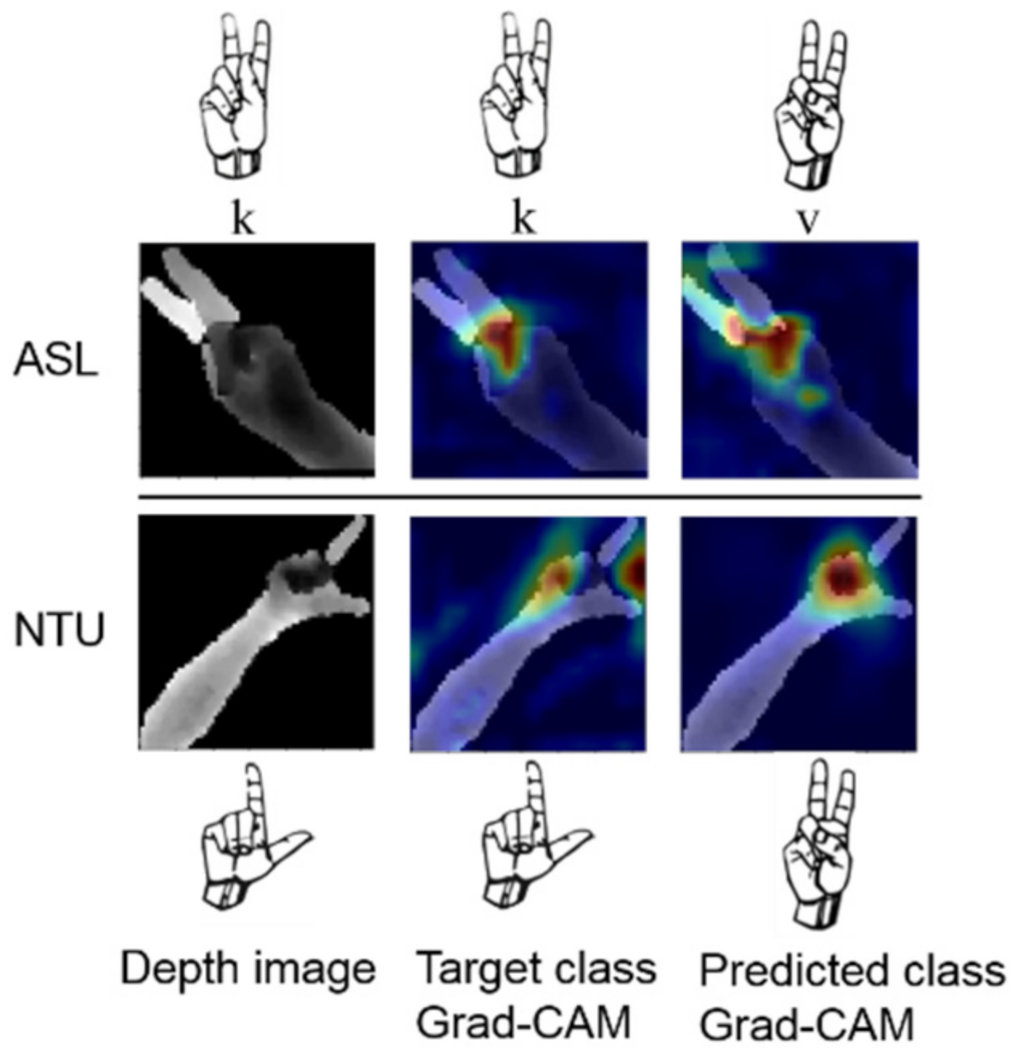
| Block | #FLOPs (B) | #Param (M) | ASL (%) | NTU (%) |
|---|---|---|---|---|
| +ASPP | 1.67 | 4.73 | 94.48(1.91) | 95.80(4.61) |
| +RFB | 3.19 | 10.69 | 94.60(1.90) | 95.50(4.55) |
| +NLRF | 3.06 | 5.45 | 95.20(2.08) | 96.50(3.63) |
| Configuration | #FLOPs (B) | #Params (M) | ASL (%) | NTU (%) | |||||
|---|---|---|---|---|---|---|---|---|---|
| r = 1 | r = 3 | r = 5 | r = 7 | vNL | |||||
| 1 | ✓ | ✓ | ✓ | ✓ | 1.67 | 4.73 | 94.48(1.91) | 96.20(3.08) | |
| 2 | ✓ *† | ✓ | ✓ * | ✓ † | ✓ | 4.47 | 6.69 | 95.25(1.80) | 96.30(3.43) |
| 3 | ✓ * | ✓ | ✓ * | ✓ | 3.06 | 5.45 | 95.11(1.72) | 96.25(3.70) | |
| 4 | ✓ * | ✓ | ✓ * | ✓ | 3.06 | 5.45 | 95.20(2.08) | 97.00(3.09) | |
| Configuration | #FLOPs (B) | #Param (M) | ASL (%) | NTU (%) | |||
|---|---|---|---|---|---|---|---|
| Backbone | DFA | NLRF | |||||
| 1 | VGG-13 | 1.43 | 10.59 | 93.50(2.30) | 89.50(6.59) | ||
| 2 | VGG-13 | ✓ | 1.59 | 10.63 | 94.26(1.94) | 91.40(4.72) | |
| 3 | VGG-9 | ✓ | 2.91 | 5.41 | 94.87(2.33) | 94.90(4.86) | |
| 4 | VGG-9 | ✓ | ✓ | 3.06 | 5.45 | 95.20(2.08) | 96.50(3.63) |
| ASL | NTU | ||||||
|---|---|---|---|---|---|---|---|
| Study | Method | Mod. | A (%) | P (%) | R (%) | F (%) | A (%) |
| Pugeault et al. [3] | RF | D | 49.00 | – | – | – | – |
| Kuznetsova et al. [37] | RF | D | 57.00 | – | – | – | – |
| Wang et al. [38] | SVM | D | 58.30 | – | – | – | 91.10 |
| Dong et al. [39] | RF | RGBD | 70.00 | – | – | – | – |
| Kane et al. [40] | SVM | D | 71.58 | – | – | – | 90.75 |
| Wang et al. [17] | TM | RGBD | 75.80 | – | – | – | 99.60 |
| Suau et al. [41] | RF | RGBD | 76.10 | – | – | – | – |
| Feng et al. [42] | SVM | D | 78.70 | – | – | – | 100 |
| Warchoł et al. [43] | HMM | D | 78.80 | – | – | – | – |
| Ameen et al. [44] | CNN * | RGBD | 80.34 | 82.00 | 80.00 | 79.20 | – |
| Nai et al. [45] | RF | D | 81.10 | – | – | – | – |
| Maqueda et al. [46] | SVM | RGB | 83.70 | – | – | – | 95.90 |
| Zhang et al. [16] | SVM | D | 83.80 | – | – | – | 94.50 |
| Keskin et al. [47] | SCF | D | 84.30 | – | – | – | – |
| Rady et al. [48] | CNN * | RGBD | 84.67 | – | – | – | 99.85 |
| Aly et al. [49] | SVM | D | 88.70 | – | – | – | – |
| Rakowski et al. [50] | ResNet * | RGBD | 90.60 | 91.80 | 90.60 | 90.30 | – |
| Tao et al. [18] | CNN * | D | 92.70 | 93.50 | 92.40 | 91.71 | 100 |
| Yang et al. [27] | DDaNet * | RGBD | 93.53 | 94.10 | 93.48 | 93.26 | 96.10 |
| Ours | RFaNet | D | 95.30 | 95.32 | 95.70 | 95.51 | 98.00 |
| Study | Method | Mod. | #Param | Accuracy (%) |
|---|---|---|---|---|
| Yang et al. [27] | DDaNet w/TF | RGBD | 21.24 M | 96.10 (4.12) |
| Yang et al. [27] | DDaNet w/o TF | RGBD | 21.24 M | 87.90 (4.75) |
| Ours | RFaNet w/TF | D | 5.45 M | 97.00 (3.09) |
| Ours | RFaNet w/o TF | D | 5.45 M | 98.00 (1.56) |
| Study | Method | Mod. | #Param | A | F |
|---|---|---|---|---|---|
| He et al. [52] | ResNet-50 | RGB | 23.60 M | – | 81.30 |
| Huang et al. [53] | DenseNet-121 | RGB | 7.04 M | – | 82.80 |
| Howard et al. [54] | MobileNet | RGB | 3.22 M | – | 86.50 |
| Dadashzadeh et al. [55] | HGR-Net | RGB | 0.499 M | – | 88.10 |
| Matilainen et al. [33] | HOG+SVM | RGB | – | 83.25 | – |
| Yang et al. [27] | DDaNet w/TF | RGBD | 21.24 M | 88.90 | 89.10 |
| Yang et al. [27] | DDaNet w/o TF | RGBD | 21.24 M | 88.10 (−0.80) | 88.25 (−0.85) |
| Ours | RFaNet w/TF | D | 5.45 M | 90.30 | 90.34 |
| Ours | RFaNet w/o TF | D | 5.45 M | 92.90 (+2.60) | 93.00 (+2.66) |
Publisher’s Note: MDPI stays neutral with regard to jurisdictional claims in published maps and institutional affiliations. |
© 2021 by the authors. Licensee MDPI, Basel, Switzerland. This article is an open access article distributed under the terms and conditions of the Creative Commons Attribution (CC BY) license (https://creativecommons.org/licenses/by/4.0/).
Share and Cite
Yang, S.-H.; Cheng, Y.-M.; Huang, J.-W.; Chen, Y.-P. RFaNet: Receptive Field-Aware Network with Finger Attention for Fingerspelling Recognition Using a Depth Sensor. Mathematics 2021, 9, 2815. https://doi.org/10.3390/math9212815
Yang S-H, Cheng Y-M, Huang J-W, Chen Y-P. RFaNet: Receptive Field-Aware Network with Finger Attention for Fingerspelling Recognition Using a Depth Sensor. Mathematics. 2021; 9(21):2815. https://doi.org/10.3390/math9212815
Chicago/Turabian StyleYang, Shih-Hung, Yao-Mao Cheng, Jyun-We Huang, and Yon-Ping Chen. 2021. "RFaNet: Receptive Field-Aware Network with Finger Attention for Fingerspelling Recognition Using a Depth Sensor" Mathematics 9, no. 21: 2815. https://doi.org/10.3390/math9212815
APA StyleYang, S.-H., Cheng, Y.-M., Huang, J.-W., & Chen, Y.-P. (2021). RFaNet: Receptive Field-Aware Network with Finger Attention for Fingerspelling Recognition Using a Depth Sensor. Mathematics, 9(21), 2815. https://doi.org/10.3390/math9212815






